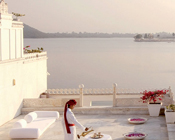Geography
With a total surface area of 3 165 596 km², India is the world’s seventh largest country. The Indian peninsula forms its own sub-continent, totally distinct from Asia, from which it was separate until the first tertiary period.
India’s geographical profile is very varied, featuring snowy landscapes, deserts, hills, plains, and plateaus. Each of India’s regions has its own climate: equatorial at the southern tip, rigorous in the Himalayas. Since India covers most of the Indian subcontinent, it boasts more than 7000 kilometers of coastlines. India is bordered by the Oman Sea (also called the Arabian Sea) to the west and to the east by the Bay of Bengal.
The fertile plains through which flow the Ganges and the Indus occupy the northern, central, and eastern territories of India, which the Deccan plateau stretches to the south. In western India lies the rock and sand of the Thar Desert. The eastern and northeastern border follows the Himalaya. The highest point of India is a controversial point following conflicts with Pakistan. According to Indian authorities, it is K2 (8 611 m) in Jammu and Kashmir. Outside this area, the highest point is Kanchenjunga, at an altitude of 8 598 meters.
India shares borders with Pakistan, China, Bangladesh, Burma (Myanmar), Nepal, Bhutan, and Afghanistan. Sri Lanka and the Maldives are Island states located south of the Indian peninsula. Politically, India is divided into 28 states, 6 federal territories and the territory of New Delhi. These divisions follow linguistic differences rather than geographical ones.

 1 (866) 722-0909
1 (866) 722-0909
 QUOTE REQUEST
QUOTE REQUEST 





































